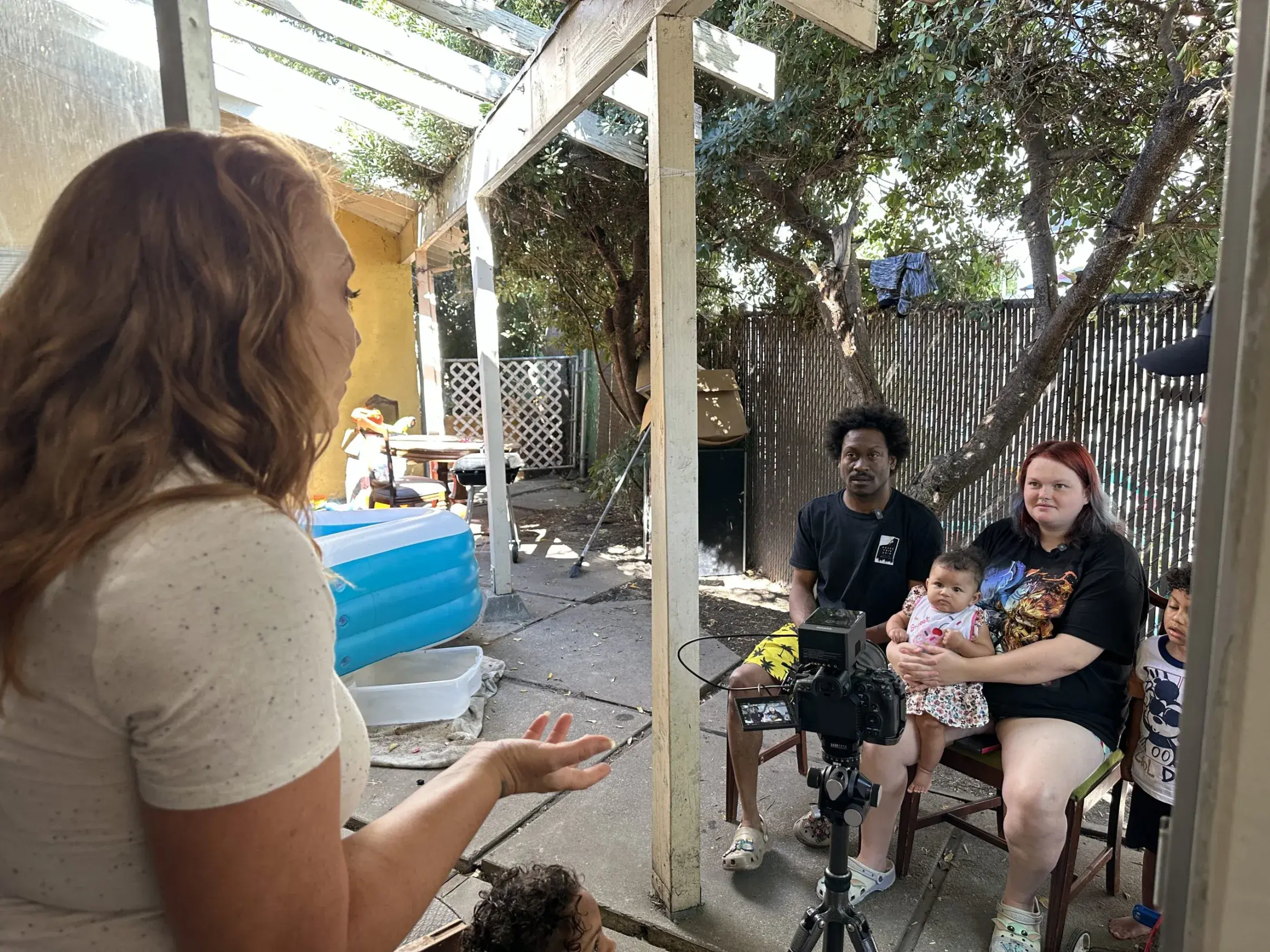It’s too hot to not have a house.
In Stockton, summer temperatures can get so high that residents are told to stay inside and avoid over exerting themselves. Not so simple, though, if you’re unhoused and have to lug your belongings everywhere you go.
“When it’s raining, you can always find shelter or create shelter,” said Michael Lopez, a 53-year-old Stockton native who has been struggling with homelessness for more than 10 years. “When it’s cold, you can build a fire, you can bundle up, you know, you can add extra clothing. But when it’s hot, what can you do? When you’re hot, you can’t do anything about it but endure it.”
As Stockton officials advance plans to prohibit camping in more public spaces – particularly in parks, where public bathrooms and drinking fountains provide access to water – unhoused residents are struggling to stay hydrated and cool.
“You know, we’re at the mercy of everybody,” Lopez said. “Right now, being homeless in Stockton is like having a bullseye on your back.”
So far this summer, Stockton police have assisted in clearing 76 encampments in the city, up from 69 last summer, according to Stockton Police Department spokesman Omer Edhah.
The city’s initiatives to clear people off the streets comes after a ruling in June by the U.S. Supreme Court that provided local governments with broad authority to remove homeless encampments. In July, Gov. Gavin Newsom urged local agencies across the state to do just that.
Several sources told CVJC they had recently noticed state and local workers clearing encampments from underpasses, parks and trails more frequently.
“Now I see everybody hanging out under the freeway because there’s shade,” said Jessica Velez, founder of Red Rabbit Advocacy Group, a Stockton nonprofit that connects unhoused people with services and advocates for their rights. “So if you continue to minimize locations for people to be, to beat the heat, they’re going to be ending up in front of stores, in front of your house, in your yard. I mean, there’s nowhere for them to go.”
Finding your cool
When temperatures in Stockton reach 100 degrees for three consecutive days, city officials issue excessive heat warnings and provide updated information about where to find air-conditioned “cooling centers,” like libraries, community centers and malls.
“The cooling centers are helpful when you can get to them,” said Rose Beasely, who said she lived on the street in Stockton off and on for 20 years. “But when you’re struggling with having to carry a whole lot of belongings and you have to think about all that weight and everything, it’s not worth it. You’re better off just finding a big five gallon jug of water and dousing yourself down and trying to keep cool that way.”
The consequences of not keeping cool when you’re homeless, including dehydration, can be dire.
Beasely, 48, said she almost died in her tent one summer as she struggled to endure Stockton’s triple-digit temperatures. Heat exhaustion would leave her drenched in sweat and unable to keep food down. She remembers being scared and too weak to do much more than lay down and cry.
“I felt like buildings were sitting on me,” she said. “I couldn’t move… When it’s hot and humid, it’s like breathing in air out of an oven. It’s like all the heat comes in and it just takes over.”
Her wails would cause her neighbors to pack up their tents and leave, she said. Luckily, one of them became so concerned about how long Beasely had been crying that they finally called for help.
At a hospital, doctors told Beasely her heart was so enlarged from being overworked that she required emergency open heart surgery. She was 45 at the time.
San Joaquin County does not track medical emergencies or deaths of unhoused people due to heat exposure, according to county officials.
“Exposure to heat may compound underlying health issues that contribute to an individual’s death,” said county spokeswoman Hillary Crowley in an email to CVJC. “It is difficult and complicated to determine death by heat exposure exclusively.”
Istvan Fazekas, spokesman for Public Health Services of San Joaquin County, agreed.
“Determining death by heat exposure is complicated and undercounted, since death certificates rarely list cause of death as heat related,” he said.
After her heart surgery, Beasely was able to secure housing with the help of Velez. Today, Beasely volunteers her time for Red Rabbit, answering the helpline and connecting her unhoused former neighbors with the resources Velez helped her find.
“You just gotta take it one day at a time,” Beasely said. “And whatever you learn, try to put it forward and help someone else, because you never know who else you might be able to help with just a few words.”

Keeping your cool
Clinics that provide medical care for unhoused residents of San Joaquin County, and work to prevent health emergencies like Beasely’s, also face challenges due to the summer heat.
Groups such as Community Medical Centers spend their days driving around the city offering resources to people camping under the freeways. But treating patients in shadeless, triple-digit heat can be dangerous for health workers.
David Lopez, director of environmental safety at CMC, said mobile teams are encouraged to stay close to clinics and cooling centers. Some days, CMC even calls them in from the field as an employee-safety measure.
“Our mobile workers tend to follow their heart, so we have to make sure we’re keeping them safe,” he said.
Dr. Lauren Brown-Berchtold, family medicine residency program director at San Joaquin General Hospital, said the heat is a concern for her unhoused patients and the staff members who treat them through the San Joaquin Health Centers’ mobile outreach clinic.
“The complexities of medical care for this population, particularly with heat waves like this, that are becoming more and more frequent, are problematic,” she said.
Brown-Berchtold and her team treat unhoused patients for dehydration, kidney failure, foot sores, and other problems. But once an examination is finished, health workers are often stuck looking for stable, clean places with water and shade to safely discharge their patients.
Beaesly imagines that an ideal place for a safe discharge would be somewhere outside, where unhoused people don’t feel like a burden on the public; a safe camping site with shade and misters where people, and in some cases their pets, could stay cool.
Looking forward with community
Beasely’s vision is actually Velez’s goal. Velez wants to create a “transitional village” in Stockton, essentially a legal campsite within the city where unhoused people can have tents, keep their belongings and pets, and maintain their relationships on the street while engaging with social service providers. During a visit to Denver, CO, Velez took inspiration from the safe outdoor spaces for unhoused people looking to transition back into mainstream society.
This summer, California lawmakers passed SB 1395, a bill that would streamline the process of building interim housing for unhoused residents, and expand an existing environmental exemption to include local governments when they approve contracts to provide services for homeless people.

In October, Velez will invite community members to get to know some of their unhoused neighbors at a town hall meeting. It will be the second such gathering in two years. The upcoming event will highlight unhoused Stocktonians’ perspectives on ways to use local land use laws to help vulnerable people.
“Last year, everyone was so enthralled with the listening sessions,” Valez said. “I encourage people to just reach out …come get to know some people, because you’re gonna fall in love. I love my chronically homeless people. I love them.”
Vivienne Aguilar is the health equity reporter for the Central Valley Journalism Collaborative in collaboration with the California Health Care Foundation (CHCF).


